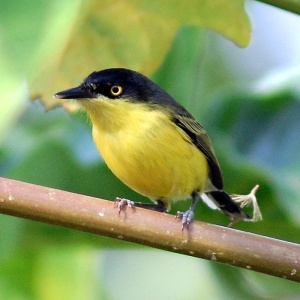
Birds catch insects less frequently in silvopastures (grazing land with substantial tree cover) than in forest fragments, according to a study in the Colombian Andes. This suggests that silvopasture provides relatively lower quality habitat for the bird species studied. However, the paper proposes some measures to improve the quality of silvopastures as habitats for birds, including encouraging certain tree species and forming particular microhabitats, such as vine tangles and hanging dead leaves.
Abstract
Wildlife-friendly agricultural practices, such as agroforestry, can play an important role in conserving biodiversity by providing and connecting habitat across working landscapes. Silvopastures (i.e. pastures with substantial tree cover), in particular, possess considerable potential for conserving biodiversity due to the dominance of pastoral landscapes in many regions. However, to balance tradeoffs between the conservation and agricultural values of these anthropogenic systems, better information on wildlife use and how it relates to habitat quality is needed. To improve our mechanistic understanding of silvopastoral habitat quality, and to develop management recommendations, we evaluated the foraging behavior of insectivorous forest birds in Andean silvopastures compared with forest fragments. Focal species' prey attack rates were >25% lower in silvopastures than in forest fragments, suggesting that arthropod prey were less abundant or accessible in silvopastures than in forest fragments. In forest fragments, birds in mixed-species foraging flocks attacked prey more frequently than solitary birds. In silvopastures, flocking and solitary birds attacked prey at similar rates, and birds foraged in flocks half as frequently as in forest fragments. Insectivorous birds preferentially foraged in a small subset of tree genera in forest fragments, but did not exhibit selective foraging in less botanically diverse silvopastures. Insectivorous species that used silvopastures foraged in microhabitats such as vine tangles and hanging dead leaves less frequently than species that did not use silvopastures. Forest species that used silvopastures may have been negatively affected by a breakdown of beneficial interspecific interactions in silvopastures, highlighting the potential for cascading effects of species loss in anthropogenic habitats. Managing silvopastures to include preferred tree species and microhabitats could improve their habitat quality for forest species, but strategies to enhance the conservation value of managed landscapes with silvopastures must also include preservation of forest fragments.
Reference
Tarbox, B.C., Robinson, S.K., Loiselle, B. and Flory, S.L., 2018. Foraging ecology and flocking behavior of insectivorous forest birds inform management of Andean silvopastures for conservation. The Condor, 120(4), pp.787-802.
Read the full paper here. See also the Foodsource chapter How do food systems affect land-use and biodiversity?












Post a new comment »